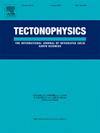Moment tensors for small earthquakes and the stress regime in the mid-Atlantic United States
IF 2.7
3区 地球科学
Q2 GEOCHEMISTRY & GEOPHYSICS
引用次数: 0
Abstract
Focal mechanisms for small magnitude earthquakes (M ∼ 1.3–4.1) in the mid-Atlantic region of the United States have been determined using a double-couple moment tensor inversion procedure. The 26 new focal mechanisms obtained, when combined with previously published mechanisms, show a pattern of reverse faulting in the easternmost portion of the study area and strike-slip faulting in the west, consistent with previous studies. The change in focal mechanisms from east to west helps to constrain the geographic location of the east-west transition in the stress regime to a NE-SW area within central Pennsylvania within proximity of the Allegheny Front. Stress inversions performed to constrain variations in the stress state across the region show that the maximum compressive stress varies only slightly, but that the near-vertical stress is the minimum compressive stress in the east and transitions to the intermediate compressive stress in the west, as expected for an east-west transition in reverse to strike-slip faulting. Analysis of driving forces causing the stress change suggests that tectonic terrane structure, glacial isostatic adjustment, and changes in gravitational potential energy have little effect on the stress field in this region, leaving the interaction of sublithospheric mantle flow with the eastern edge of the Laurentian cratonic lithosphere beneath central Pennsylvania as a primary explanation. The cratonic lithospheric keel may cause a deflection in mantle flow, thereby changing the stress field enough so that the magnitude of the vertical stress in relation to the minimum horizontal stress results in strike-slip as opposed to reverse faulting.
美国中大西洋地区小地震的矩张量和应力状态
使用双偶矩张量反演程序确定了美国大西洋中部地区小震级地震(M ~ 1.3-4.1)的震源机制。新发现的26个震源机制与已有的震源机制相结合,表明研究区最东端为逆断裂,最西端为走滑断裂,与前人的研究结果一致。震源机制从东向西的变化有助于将应力状态中东西过渡的地理位置限制在宾夕法尼亚州中部靠近阿勒格尼前线的NE-SW区域。为限制应力状态的变化而进行的应力反演表明,最大压应力变化不大,但近垂直应力在东部是最小压应力,在西部过渡到中间压应力,与走滑断裂相反的东西过渡是预期的。应力变化的驱动力分析表明,构造地体结构、冰川均衡调整和重力势能变化对该地区应力场的影响不大,岩石圈下地幔流与宾夕法尼亚州中部劳伦森克拉通岩石圈东部边缘的相互作用是主要的解释。克拉通岩石圈龙骨可能引起地幔流的偏转,从而足以改变应力场,从而使垂直应力相对于最小水平应力的大小导致走滑,而不是反向断裂。
本文章由计算机程序翻译,如有差异,请以英文原文为准。
求助全文
约1分钟内获得全文
求助全文
来源期刊

Tectonophysics
地学-地球化学与地球物理
CiteScore
4.90
自引率
6.90%
发文量
300
审稿时长
6 months
期刊介绍:
The prime focus of Tectonophysics will be high-impact original research and reviews in the fields of kinematics, structure, composition, and dynamics of the solid arth at all scales. Tectonophysics particularly encourages submission of papers based on the integration of a multitude of geophysical, geological, geochemical, geodynamic, and geotectonic methods
 求助内容:
求助内容: 应助结果提醒方式:
应助结果提醒方式:


